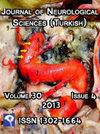A probable extraordinary etiology of a reduntant nerve root syndrome : lomber spondylolisthesis
Q Medicine
引用次数: 0
Abstract
The description of redundant nerve root syndrome (RNRS) is known as large, elongated and tortuous nerve roots with a severe lumbar stenosis. It is considered that the cause is chronic compression of the nerve roots. To the best of our knowledge, this is the first case of RNRS related with lumbar spondylolisthesis without lumbar canal stenosis in the English literature. In this case report, we have presented a patient who had been diagnosed as RNRS in association with lumbar spondylolisthesis. The Magnetic resonance imaging (MRI) and peroperative observation of the clinical entity are discussed.余神经根综合征的一个可能的特殊病因:腰椎滑脱
神经根冗余综合征(RNRS)的描述被称为大,延长和弯曲的神经根与严重的腰椎狭窄。其原因被认为是神经根的慢性压迫。据我们所知,这是英文文献中第一例与腰椎滑脱相关的无腰椎管狭窄的RNRS病例。在这个病例报告中,我们提出了一个被诊断为与腰椎滑脱相关的RNRS的患者。讨论了临床实体的核磁共振成像(MRI)和术中观察。
本文章由计算机程序翻译,如有差异,请以英文原文为准。
求助全文
约1分钟内获得全文
求助全文
来源期刊

Journal of Neurological Sciences-Turkish
NEUROSCIENCES-
CiteScore
0.12
自引率
0.00%
发文量
0
审稿时长
4-8 weeks
 求助内容:
求助内容: 应助结果提醒方式:
应助结果提醒方式:


